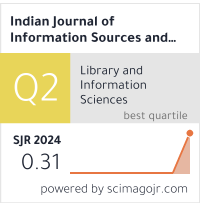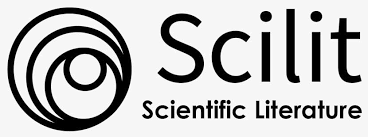Scientometric Analysis of Vikalpa: The Journal for Decision Makers (2008-2017)
DOI:
https://doi.org/10.51983/ijiss.2019.9.S1.575Keywords:
Bibliometrics, Scientometric Analysis, Authorship Pattern, Degree of Collaboration, Growth Rate, Doubling TimeAbstract
This study aims to present a scientometric analysis of the journal titled vikalpa: the journal for decision makers” for the period from 2008 to 2017. The present study was conducted with an aim to provide a summary of research activity in the current journal and characterize its most important aspects. The analysis covers mainly the year wise distribution of articles, category wise classification of papers, authorship patterns of papers, the degree of collaboration, most prolific contributions of papers, institution-wise distribution of contributions and geographical distribution of papers of the journal. The analysis showed that 325 papers were published in the journal of vikalpa: the journal for decision makers” for the period from 2008 to 2017. The maximum number of publication was recorded in 2014 (39 articles, 12.00%) while the minimum was in the year 2017 (21 articles, 6.46%). The authorship pattern was studied to determine the percentage of single and multiple authorship. It is observed from the study that a single author 114(35.08%) paper occupied the 2nd rank. Two author paper 132(40.62%) occupied in 1st rank. Three author paper 41 (12.62 %) occupied in 3rd rank and more than three author paper 38(11.69%) occupied in 4th rank. The study exposes that during 2008-17 the highest proportion of papers were by single authors 114 followed by papers with two authors 211, and more than three authors 325. Among the ten years of the study period, the highest degree of collaboration occurred in the year of 2012. The growth rate is 0.72 in 2008 and which decreased up to 0.07 in 2017. The mean relative growth rate for the periods of 2008 to 2017 the relative growth rate of 0.223. This study period resulted that the mean doubling time for total output 4.088 years. It is observed from the study that the highest number of contributors is belonging to India with 270 articles out of 325 total articles published and its percentage is 83.08 %.
References
Mamdapur, N., & Rajgoli, U. (2013). Scientometric analysis of contributions to the journal College and Research Libraries. Library Philosophy and Practice, 2179, 1-16. http://digitalcommons.unl.edu/cgi/viewcontent.cgi?article=2179&context=libphilprac.
Surulinathi, M., Balasubramani, R., & Kalisdha. (2013). Continent-wise analysis of green computing research: A scientometric study. Journal of Advances in Library and Information Science, 2(1), 39-44.
Sivankutty, V. S. (2014, August). Reaching the unreached metrics of trends. Paper presented at the TEQIP National Conference, Coimbatore.
Vijayakumar, P. (2014, August). Reaching the unreached: A bibliometric analysis of the journal Neurology India (2002-2011). Paper presented at the TEQIP National Conference, Coimbatore.
Surulinathi, M. (2010). An evaluative study of Wi-Fi communication research publications: A scientometric study. Journal of Information Management Technology, 1(1), 32-40.
Esmail, S. (2015, March). Advancement of science through scientometrics: A scientometric analysis of the journal Annals of Library and Information Studies. Paper presented at the UGC SAP National Conference, Coimbatore.
Garg, K. C., Kumar, S., & Lal, K. (2006). Scientometric profile of Indian agricultural research. Technology and Development Studies, 68(1), 151-166.
Arunachalam, S., & Gunasekaran, S. (2002). Tuberculosis research in India and China: From bibliometrics to research policy. Current Science, 82(8), 933-947.
Ravi, S., & Kumar, M. (2007). A scientometric analysis of tuberculosis research in India. International Journal of Information Science and Services, 1(1), 32-39.
Scopus. Retrieved from http://www.info.scieverse.com/scopus/about.
Dutt, B., Kumar, S., & Garg, K. C. (2010). Scientometric profile of global dengue research. Collnet Journal of Scientometrics & Information Management, 4(1), 81.
Gupta, R., Gupta, B. M., Kshitij, A., & Bala, A. (2014). Glaucoma research: A scientometric study of Indian publications output, 2002-11. DESIDOC Journal of Library & Information Technology, 34(1), 35-45.
Bhardwaj, R. K. (2014). Dengue research: A scientometric mapping of world publications. SRELS Journal of Information Management, 51(2), 77-86.
Bhardwaj, R. K. (2014). Dengue fever: A bibliometric analysis of India’s contributions to the research literature of this dangerous tropical disease. Science & Technology Libraries, 33(3), 289. Available at http://doi:10.1080/0194262X.2014.943117 (Accessed on 04 Oct 2017).
Eom, S. H., Bamne, A. B., Chowdhry, M., Chae, I. S., & Kim, T. K. (2015). Bibliometric analysis of orthopedic literature on total knee arthroplasty in Asian countries: A 10-year analysis. Knee Surgery & Related Research, 27(3), 149-155.
Gupta, R., Dhawan, S. M., Gupta, B. M. (2017). World Rabies Research Output: A Scientometric Assessment of Publication Output during 2006-15. Journal of Scientometric Research, 5(3), 220-229.
Downloads
Published
How to Cite
Issue
Section
License
Copyright (c) 2019 The Research Publication

This work is licensed under a Creative Commons Attribution-NonCommercial-NoDerivatives 4.0 International License.









